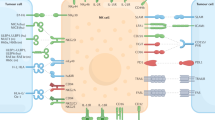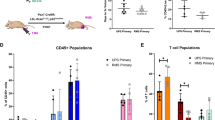Abstract
Natural killer (NK) cells, which occur at high levels in normal non-immune individuals of several species, have the capacity to lyse certain tumour cells in vitro, and have been proposed as a first level of defence against tumour growth in vivo1–3. Evidence for this comes mainly from the murine system, where certain FI hybrid or T-cell deficient mice with high NK activity resist growth of transplanted tumours better than do normal syngeneic controls with lower NK activity4–6. Recent studies of the beige mutation on the C57BL mouse strain background, previously proposed as an animal homologue of the human Chediak-Higashi syndrome7,8, have revealed a new model for analysing anti-tumour effector mechanisms in the intact syngeneic host9,10. The recessive beige gene (bgJ), which affects melanosome and granulocyte lysosome functions11,12, also causes a profound (but not total) depression of NK activity whereas other anti-tumour effector mechanism mediated by T cells and macrophages remain relatively intact13. It was important, therefore, to test the tumour susceptibility of beige mice as a first direct test of the hypothesis that NK cells are involved in surveillance against neoplasia. In partial confirmation of this hypothesis, we report here that failure of small threshold doses of one virally and one chemically induced transplantable leukaemia to grow out in syngeneic mice partly depends on a rapidly acting host defence mechanism. This mechanism is deficient in bg/bg mice, which develop palpable, progressively growing tumours faster and at a higher frequency than do phenotypically normal +/bg littermates.
This is a preview of subscription content, access via your institution
Access options
Subscribe to this journal
Receive 51 print issues and online access
$199.00 per year
only $3.90 per issue
Buy this article
- Purchase on Springer Link
- Instant access to full article PDF
Prices may be subject to local taxes which are calculated during checkout
Similar content being viewed by others
References
Kiessling, R. & Wigzell, H. Immun. Rev. 44, 165–208 (1979).
Herberman, R. B. & Holden, H. T. Adv. Cancer Res. 27, 305–377 (1977).
Haller, O., Hansson, M., Kiessling, R. & Wigzell, H. Nature 270, 609–611 (1977).
Petranyi, G. et al. Immunogenetics 3, 15–28 (1976).
Warner, N. L., Woodruff, M. F. & Burton, R. C. Int. J. Cancer 20, 146–153 (1977).
Kiessling, R., Petranyi, G., Klein, G. & Wigzell, H. Int. J. Cancer 17, 275–281 (1976).
Windhurst, D. B. & Padgett, G. J. invest. Derm 60, 529–537 (1973).
Blume, R. S. & Wolff, S. M. Medicine, Baltimore 51, 247–280 (1972).
Roder, J. C. & Duwe, A. K. Nature 278, 451–453 (1977).
Roder, J. C. J. Immun. 123, 2168–2173 (1979).
Gallin, J. I., Bujak, J. S., Palten, E. & Wolff, S. M. Blood 43, 201–206 (1974).
Elin, R. J., Edelin, J. B. & Wolff, S. M. Infect. Immun. 10, 88–91 (1974).
Roder, J. C., Lohmann-Matthes, M. -L., Domzig, W. & Wigzell, H. J. Immun. 123, 2174–2181 (1979).
Harmon, R. C., Clark, E. A., O'Toole, C. & Wicker, L. S. Immunogenetics 4, 601–607 (1977).
Klein, G., Klein, G. O., Kärre, K. & Kiessling, R. Immunogenetics 7, 391–404 (1978).
Carlson, G. A. & Wegman, T. G. J. Immun. 118, 2130–2137 (1977).
Carlson, G. A., Melnychuk, D. & Meeker, M. J. Int. J. Cancer 25, 111–122 (1980).
Riccardi, C., Pucetti, P., Santoni, A. & Herberman, R. B. J. natn. Cancer Inst. 63, 1041–1045, 1979.
Herberman, R. B. et al. Immun. Rev. 44, 43–70 (1979).
Herberman, R. B., Nunn, M. E., Holden, H. T., Staal, S. & Djeu, J. Y. Int. J. Cancer 19, 555–562 (1977).
Greenberg, A. H. & Greene, M. Nature 264, 356–369 (1976).
Chow, D. A., Greene, M. I. & Greenberg, A. H. Int. J. Cancer 23, 788–797 (1979).
Roder, J. C. et al. Nature 284, 553–555 (1980).
Dent, P. B., Fish, L. A., White, J. F. & Good, R. A. Lab. Invest. 15, 1634–1642 (1966).
Talmadge, J.E., Meyers, K.M., Prieur, D.J. & Starkey, J.R. Nature 284, 622–624 (1980).
Julius, M. H., Simpson, E. & Herzenberg, L. A. Eur. J. Immun. 3, 645–653 (1973).
Author information
Authors and Affiliations
Rights and permissions
About this article
Cite this article
Kärre, K., Klein, G., Kiessling, R. et al. Low natural in vivo resistance to syngeneic leukaemias in natural killer-deficient mice. Nature 284, 624–626 (1980). https://doi.org/10.1038/284624a0
Received:
Accepted:
Issue Date:
DOI: https://doi.org/10.1038/284624a0
This article is cited by
-
Tumor immune escape mechanisms: impact of the neuroendocrine system
Cancer Immunology, Immunotherapy (2006)
-
Human breast cancer cell line xenografts as models of breast cancer — The immunobiologies of recipient mice and the characteristics of several tumorigenic cell lines
Breast Cancer Research and Treatment (1996)
-
Effect of arginase on splenic killer cell activity in patients with gastric cancer
Digestive Diseases and Sciences (1994)
-
Orthotopic implantation is essential for the selection, growth and metastasis of human real cell cancer in nude mice
CANCER AND METASTASIS REVIEW (1990)
-
The in vivo clearance of Ha-ras transformants by natural killer cells
Clinical & Experimental Metastasis (1990)
Comments
By submitting a comment you agree to abide by our Terms and Community Guidelines. If you find something abusive or that does not comply with our terms or guidelines please flag it as inappropriate.



